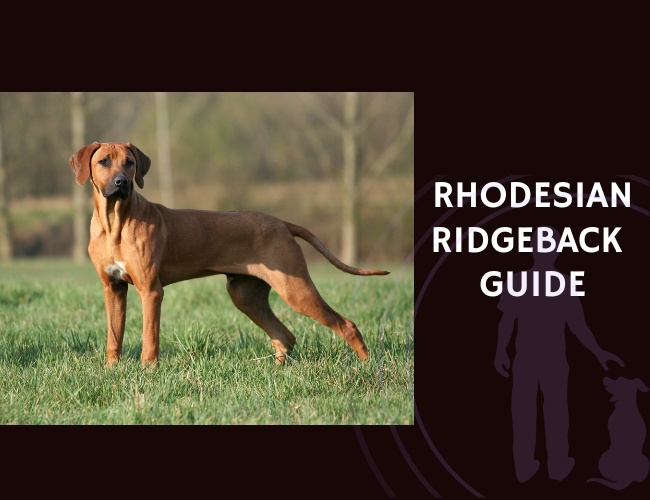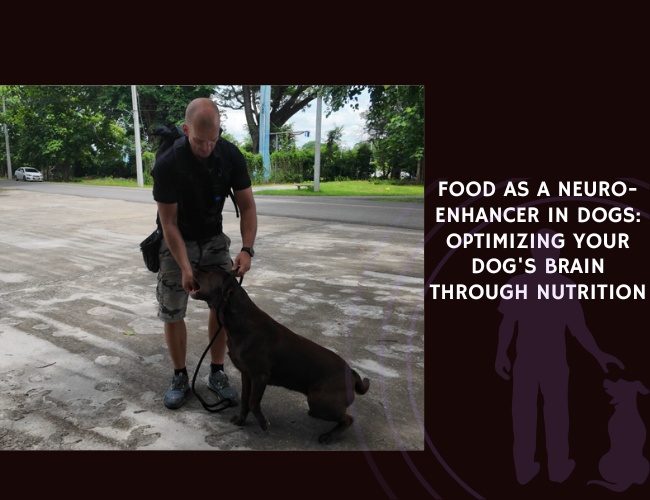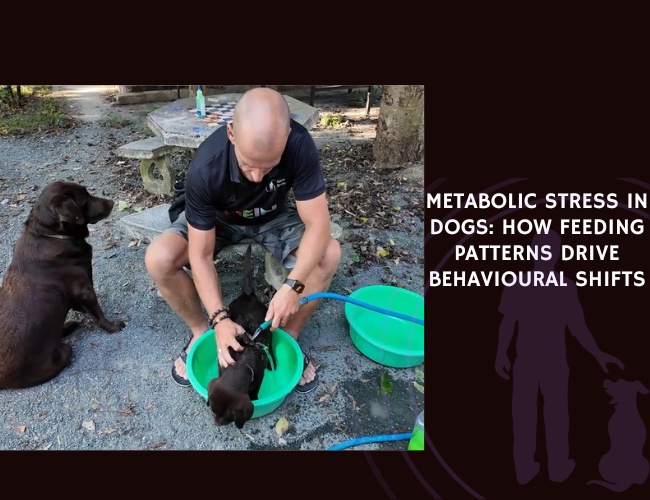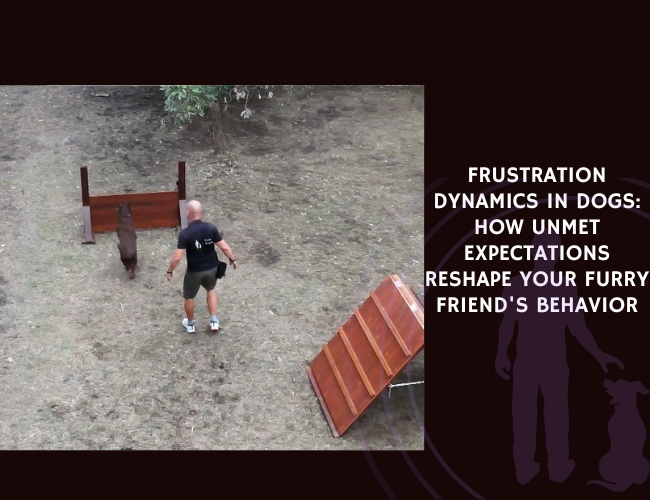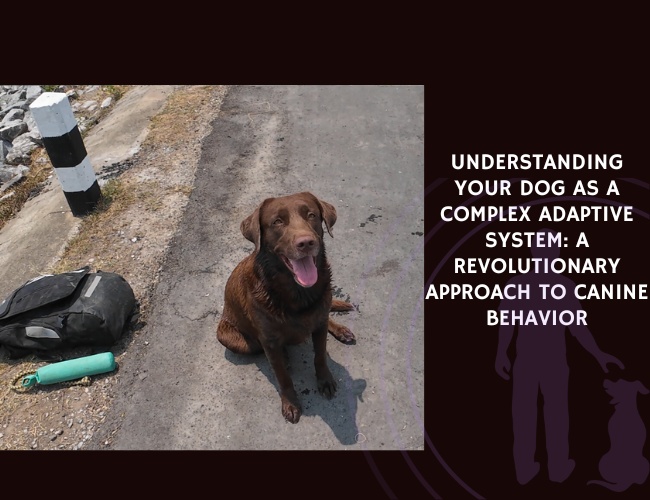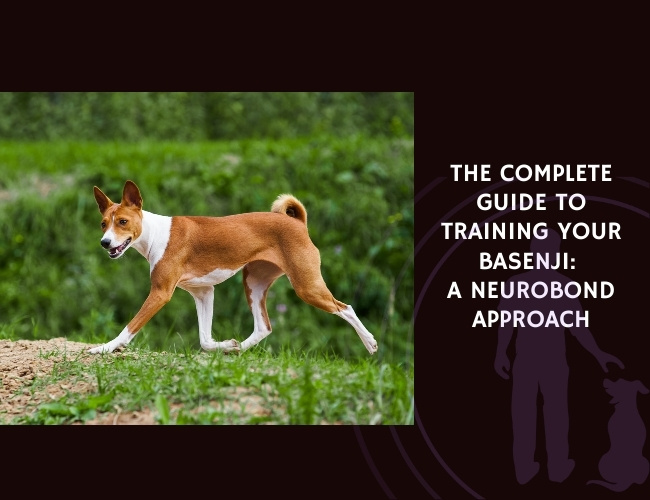Introduction to the Rhodesian Ridgeback
Roots in Southern Africa
The Rhodesian Ridgeback originated in Southern Africa. These dogs were bred for both tracking lions and protecting livestock. Their unusual courage and resilience made them reliable companions for hunters. Early settlers developed the breed by mixing local dogs with imported breeds, focusing on traits like stamina, independence, and obedience. This created a dog able to face tough environments and stand up to dangerous wildlife, while still forming strong bonds with its people.
Unique Appearance and That Famous Ridge
One key feature that makes the rhodesian ridgeback stand out is the ridge of hair running along its back. This ridge grows in the opposite direction from the rest of the coat and forms a distinct stripe. It comes from a specific genetic trait and can be seen in puppies from birth. Ridgebacks are large and muscular, weighing between 30kg and 39kg, with a short, dense coat that is usually light to red wheaten in color. Their athletic build supports their original working role, and their well-proportioned body allows for speed and endurance.
Other physical qualities include:
- A broad head and rounded ears
- A long, straight tail
- Powerful legs for running and leaping
These features help rhodesian ridgebacks stay healthy and active, supporting their need for regular exercise.
Temperament: Built for Adventure, Not for Beginners
The rhodesian ridgeback is confident, independent, and loyal. Anyone looking for a devoted companion will find one in this breed. However, they are also thoughtful and a bit reserved, especially around strangers. These dogs do not often act out of fear, but prefer to observe before acting.
Their independent thinking means they like to make choices for themselves. This can make training a challenge for new dog owners. Ridgebacks tend to be happiest with experienced handlers who can offer consistent leadership, patience, and positive reinforcement.
While they are gentle with their family, their protective side can show if they sense a threat. They mature emotionally at a slower rate than many dogs, so ongoing support and guidance is important. Understanding these characteristics helps ensure that both dog and humans build a strong, positive relationship.
With this foundation, we can better appreciate their unique personalities and what makes them special pets.
Character & Behavior Traits
Independence and Territorial Instincts
Rhodesian ridgebacks are well-known for their independent nature. This trait goes back to their origins as lion-tracking and guarding dogs in Southern Africa. Independence helped them make quick decisions in the field, working both with teams and on their own. Today, this independence often shows as a strong-willed character at home. They do not always follow commands blindly and tend to think for themselves.
Ridgebacks also have a strong sense of territory. They are natural guardians who may be wary around new people or animals. While they’re not aggressive by default, their protectiveness means they notice everything happening in their environment. If left unchecked or unsocialized, their guarding instinct could turn into overprotectiveness or defensive behaviors. Early exposure to various situations, people, and places is crucial for a well-adjusted ridgeback.
Loyalty and Family Bonds
Despite their independent nature, ridgebacks are incredibly loyal. They build deep connections with their family and thrive when included as an important member of the household. Many owners note that their ridgeback is affectionate and gentle at home. This breed loves spending time with family, often following them from room to room. However, this loyalty can have a flip side; ridgebacks may act warily toward strangers or new animals in an effort to protect their loved ones.
Sensitivity and Late Maturity
Rhodesian ridgebacks are sensitive dogs—not only emotionally, but also in how they respond to training and handling. They do not respond well to harsh corrections or punishment. Instead, they need patient, supportive, and consistent training with plenty of positive reinforcement. It is important for owners to recognize their emotional needs, especially during training sessions.
Another unique trait of the breed is their late social and emotional maturity. While many dogs settle into adulthood by two years, ridgebacks may remain puppy-like and impulsive well past that age. Owners should plan for extended guidance and reinforcement, supporting their ridgeback’s growth with understanding and patience.
With these insights into their unique character, owners can help nurture a balanced and happy companion.
Training & Socialization
The Importance of Early and Consistent Socialization
Rhodesian ridgebacks are known for their independence and territorial instincts, which come from their history as hunters and guard dogs in Southern Africa. Early and consistent socialization is vital for them. Without it, these natural traits can turn into unwanted behaviors, such as fear-based aggression or being overly suspicious of strangers. The best time to start is when the dog is very young—exposing your ridgeback puppy to a wide variety of people, places, sounds, and animals. This hands-on approach helps develop a stable and confident adult dog. Puppies that are properly socialized are less likely to react fearfully or aggressively in new situations, making them easier to manage and happier overall.
Positive Reinforcement: The Way to Train
Training a ridgeback is rewarding, but it requires patience and consistency. Because of their intelligence and strong will, it’s important to use positive reinforcement techniques. This means rewarding your dog with treats, praise, or play whenever they follow a command or show good behavior. Punishment or harsh correction is discouraged as it may cause fear or damage the relationship between you and your dog. Instead, keeping training sessions short, upbeat, and engaging works best. Focus on reinforcing impulse control, teaching recall, and building a strong bond. Remember, ridgebacks mature slowly, so training should continue well into their adolescence and even adulthood.
Instinct-Matching Activities
These dogs are driven by their inherited instincts. Regular training should go beyond basic sit and stay commands. Including activities that satisfy their hunting and scenting impulses—like scent work, tracking games, or controlled guarding exercises—makes training fun and mentally fulfilling for them. These activities not only prevent boredom but also reduce the chance of destructive behaviors, keeping your home and bond intact.
Training a ridgeback is an ongoing journey. Each day builds better communication, trust, and well-being for both you and your companion. With the right approach, you and your ridgeback will thrive together.

Nutritional Requirements
Caloric Intake for Large, Athletic Dogs
Rhodesian ridgebacks are large, powerful, and very active. Managing their caloric intake is crucial from puppyhood through adulthood. Too many calories, especially when young, can lead to fast growth and extra weight, which put stress on developing joints. Instead, meals should be measured, and treats kept to a minimum to help prevent joint problems later in life. Remember, every dog is unique. Factors like age, activity level, and health mean meal plans may need tweaks along the way.
Balanced Nutrient Ratios
A balanced diet for ridgebacks should match standards set by the European Pet Food Industry Federation (FEDIAF) and Association of American Feed Control Officials (AAFCO). These guidelines ensure large-breed dogs get enough protein to build strong muscles, healthy fats for energy, and a complete mix of vitamins and minerals for everyday body functions.
Key nutrients include:
- Animal-based protein for muscle growth
- Essential fatty acids for skin, coat, and brain health
- Vitamins and minerals to support the immune system and organ health
For growing puppies and adults, large-breed formulas are best because they lower the risk of joint problems by controlling calcium and phosphorus levels.
Bloat Prevention and Joint Support
Bloat, also called gastric dilatation-volvulus, is a life-threatening risk for this breed. To lower the chances:
- Feed two or three smaller meals a day, not one big meal
- Use a slow feeder bowl to avoid gulping
- Avoid exercise right after eating
- Talk to a vet about meal timing and any other concerns
For joint support, consider foods or supplements containing glucosamine, chondroitin, and omega-3 fatty acids. These nutrients help keep joints cushioned and may ease wear and tear as your ridgeback ages.
Special Dietary Considerations
Some ridgebacks have sensitive stomachs or food allergies. Watch for signs like itching, ear infections, or stomach upset, and work with your vet to identify and manage any issues. Safety and health always come first, so if you notice anything odd after meals, check with a professional.
Healthy nutrition is the first step in helping your ridgeback thrive—physically and mentally. This ensures a strong foundation for their active lifestyle and helps avoid many common health issues down the road.
Strength. With. Soul.
Confidence is coded into their DNA.
The Rhodesian Ridgeback doesn’t bluff. This dog carries a quiet strength, born from generations of tracking lions and protecting what mattered. It doesn’t bark without reason, and it doesn’t follow without purpose. You don’t “own” a Ridgeback—you earn their respect. But once you do, it’s a bond built on depth, not demand.
Independence isn’t disobedience.
They think before they act. They weigh decisions. That’s not stubbornness—it’s discernment. A Ridgeback doesn’t perform tricks for praise. It acts out of clarity and trust. Training this breed means learning to lead, not to dominate.
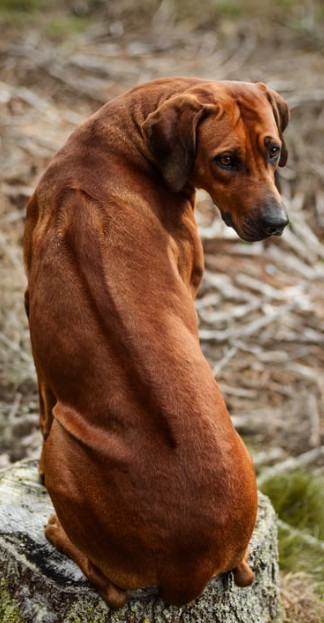
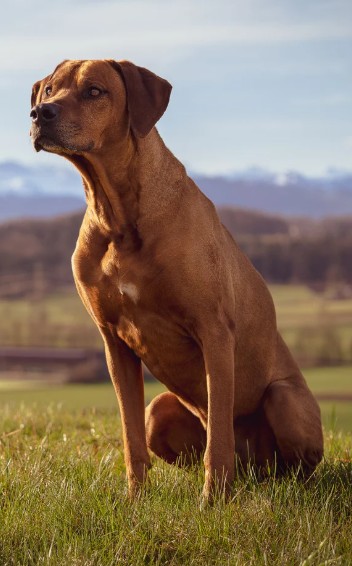

Guardians with grace.
This breed protects, but never panics. Observant. Discerning. Calm under pressure. They won’t lash out—but they will step in if you’re threatened. And at home, they’re shadows of love: gentle giants resting at your feet, ever watchful, always near.
Health Concerns & Genetic Conditions
Dermoid sinus: screening, management, and breeding implications
Dermoid sinus is one of the key inherited conditions in the Rhodesian Ridgeback. This condition is a defect of the skin and spinal cord, most often noticed as a tube or lump along the back or neck. It is present from birth and can lead to infections or discomfort if left untreated. Early screening is essential. Vets may use careful palpation or ultrasound to detect it in puppies. If found, surgical correction is usually the recommended treatment. Because dermoid sinus is inherited, mindful breeding is necessary—dogs with this defect should not be bred, as it can pass to future generations. Consistent health checks help reduce its occurrence and keep puppies healthier overall.
Joint issues: hip and elbow dysplasia
Like many large breeds, Rhodesian Ridgebacks are prone to hip and elbow dysplasia. These are conditions where joints do not form correctly, sometimes leading to pain or early arthritis. Responsible breeders use evaluation techniques such as Orthopedic Foundation for Animals (OFA) or PennHIP radiographs to check for signs before breeding. Symptoms can appear as stiffness, reluctance to walk, or a change in gait. Early detection allows owners to manage symptoms with diet, exercise, and, if needed, medication or surgery. Regular exercise that is suited to large, athletic breeds helps keep joints healthy but should avoid high-impact activities for growing puppies.
Other breed-specific health concerns
Rhodesian Ridgebacks may also develop hypothyroidism, a condition where the thyroid gland is underactive, causing tiredness or weight gain. Simple blood tests can help diagnose and monitor this condition. Another serious risk is gastric dilatation-volvulus (bloat). This life-threatening emergency affects many deep-chested breeds, so owners must know the signs—like a swollen belly or retching—and act fast if they appear. Prevention strategies include smaller, frequent meals and avoiding heavy exercise right after eating.
Good health starts with regular veterinary check-ups and clear communication with breeders. By following screening guidelines and knowing what to watch for, owners can help keep their Ridgebacks happy and healthy.
Understanding these health challenges leads owners to better management routines and thoughtful care for their dogs.
Exercise & Mental Stimulation Needs
Physical Activity Requirements
Rhodesian Ridgebacks are built for action. Their history as lion-tracking and guarding dogs in Southern Africa means they have high energy needs. To keep their bodies and minds healthy, these dogs need at least ninety minutes of structured exercise each day. This can include brisk walks, runs, or even safe off-leash time in a securely fenced area. Without enough daily activity, they can become bored, which may lead to destructive behaviors or restlessness.
It’s important to note that while adults thrive on intense play and exercise, puppies and young Ridgebacks are still growing, so avoid high-impact activities until their joints are fully developed. Activities like moderate leash walks, gentle games of fetch, and supervised play with other dogs work well for young Ridgebacks until their bodies mature.
Mental Stimulation Strategies
Mental stimulation is just as important as physical exercise for this breed. Rhodesian Ridgebacks are intelligent and independent thinkers. Engaging their brains prevents boredom and the development of bad habits. Mental activities can include:
- Nose work games, where you hide treats or toys for them to find
- Puzzle feeders or interactive toys
- Short and fun training sessions teaching new commands or tricks
- Scent work or basic tracking tasks in your backyard or during walks
These activities mimic their natural instincts and keep them mentally sharp!

Instinct-Matching Activities
Because of their hunting background, Rhodesian Ridgebacks enjoy activities that let them use their senses and intelligence. Try including:
- Tracking games using scent trails
- Supervised agility courses
- Controlled, positive defensive training that channels their guarding instincts
- Fetch or tug games with clear boundaries
Matching their activities to their biology helps satisfy their deep-rooted needs and builds a stronger bond between you and your dog.
Remember, regular mental and physical exercise leads to a happier and more well-behaved companion. Your Ridgeback will thrive when their instincts, minds, and bodies are all engaged!
With the right approach, you can provide a fulfilling life for your Rhodesian Ridgeback as you shape their overall well-being.
Living Environment & Housing
Space and Adaptability
Rhodesian ridgebacks are large, active dogs that thrive in homes with plenty of room to move. While they can adapt to apartment living, daily exercise—at least 90 minutes—is a must to keep them healthy and happy. Ideally, a ridgeback will have access to a secure yard where they can run, sniff, and play. Open space gives them a healthy outlet for their energy and helps prevent boredom or frustration. However, if a large outdoor area is not available, regular walks, adventures in parks, and mental-stimulating activities can help meet their needs.
Secure Fencing: A Non-Negotiable
Due to their strong prey drive and curious nature, secure fencing is critical for every ridgeback home. These dogs are known for their problem-solving skills and may leap or dig under fences if motivated by wildlife or interesting scents. Fencing should be sturdy, at least 1.8m in height, and checked regularly for gaps or weak spots. This approach keeps your ridgeback safe from escaping and helps protect local wildlife from an enthusiastic chaser. Never leave a ridgeback unsupervised in an unfenced area, as their instincts can take over quickly.
Meeting Physical and Emotional Needs
A comfortable home environment is more than just space—it’s about meeting a ridgeback’s unique physical and psychological needs. These dogs love being part of family life and need to be included in daily routines. Provide a cozy bed indoors for rest and offer toys, puzzle feeders, or scent games for mental stimulation. Social interactions with humans and opportunities for supervised play with other friendly dogs are also supportive for their well-being. Ridgebacks value consistency and calm leadership, so routines around feeding, exercise, and quiet time are very helpful.
By providing both a safe physical space and an emotionally supportive home, you’ll help your ridgeback thrive in any living situation. Understanding these needs will help you build a trusting, fulfilling relationship with your companion.
Is a Rhodesian Ridgeback Right for You?
Owner experience and time commitment
Choosing a Rhodesian ridgeback means stepping into a role that requires both experience and dedication. This breed is known for strong independence and a desire for clear, consistent leadership. Experienced owners—those who have previously raised large, active dogs—are often better prepared for what ridgebacks need. They require daily, structured exercise for at least 90 minutes, along with active mental engagement to prevent boredom or destructive behavior.
Owning a ridgeback is not a part-time commitment. These dogs thrive on routine, reliable boundaries, and training throughout their lives. Lapses can lead to unwanted behaviors such as destructiveness or guarding issues. A supportive family environment is key, as ridgebacks bond deeply and expect to belong in daily routines.
Lifestyle compatibility assessment
Before welcoming one into your home, consider your living environment and lifestyle. Ridgebacks need space—ideally a house with a secure, 1.8m fence and access to safe areas for exercise. Apartments may work only if daily activity needs are met.
Ask yourself:
- Do you enjoy long, active outings such as hiking or running?
- Can you provide structure and training?
- Is your schedule consistent enough to devote daily time to exercise and companionship?
If your routine involves frequent travel, long work shifts, or little time at home, another breed may suit you better. Ridgebacks can adapt, but not if left alone for long periods or denied the physical and mental challenges they crave.
Common challenges and rewards
Potential challenges include managing natural independence, strong prey drive, and late emotional maturity. Ridgebacks often test boundaries and may be stubborn, especially if training is inconsistent or too harsh. They need owners who are patient, use positive reinforcement, and remain calm under pressure.
Despite the work, ridgebacks offer immense rewards. They are deeply loyal, protective, and make loving additions to families who welcome their spirited personality. Their courage, intelligence, and affection shine brightest with responsive, professional handling.
Next, we’ll explore responsible ways to care for your ridgeback, ensuring a healthy and happy partnership.
Responsible Ownership & Care
Commitment to Health
Responsible care for a Rhodesian ridgeback means prioritizing regular veterinary visits. Annual check-ups help catch health concerns early, including genetic conditions such as dermoid sinus, hip and elbow dysplasia, and hypothyroidism. You may need specific screenings, like palpation or ultrasound exams for dermoid sinus, and orthopedic evaluations (OFA or PennHIP) for joint health. Keep an open dialogue with your vet to address emerging issues and maintain up-to-date vaccine and parasite prevention schedules. This steady relationship supports long-term health and can prevent life-altering issues 🩺.
Lifelong Training and Socialization
Training and socialization are not short-term projects with this breed—they are essential for the dog’s whole life. Begin socialization early and keep building on it through adolescence since ridgebacks mature slowly. Introduce your puppy to new people, places, and friendly animals in a positive, safe way. Rely on gentle, supportive techniques, since these dogs are sensitive to harsh methods. Positive reinforcement is key: reward good behavior with treats, praise, or play instead of punishment. Ongoing mental stimulation—like scent games or obedience classes—helps maintain a well-adjusted companion. If issues emerge, consult professionals or breed-savvy trainers.
Support Networks and Resources
You never have to go it alone. Many breed clubs, both local and national, offer excellent guidance for owners. Clubs often provide health information, recommended training contacts, and behavioral advice specific to ridgebacks. Online forums and community groups can offer peer advice and support if you need a sense of community or quick answers to everyday issues. For complicated questions, don’t hesitate to reach out directly to your breeder, local ridgeback club, or a veterinary behaviorist familiar with hounds.
By focusing on routine healthcare, ongoing training, and community support, you create the foundation for a happy, healthy partnership with your Rhodesian ridgeback. Now, let’s talk about real-world experiences and what you can expect throughout your journey as an owner.

